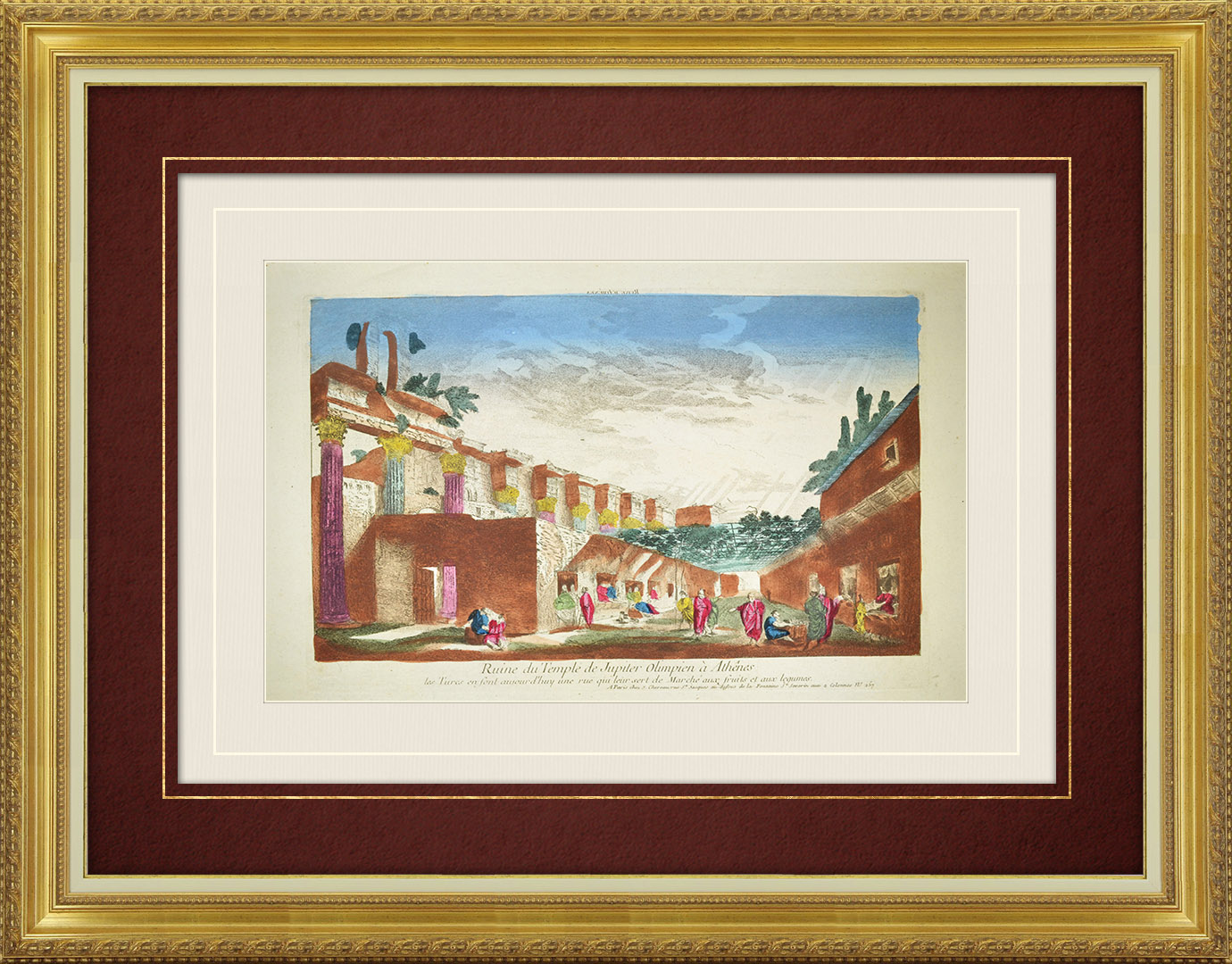
Original title
Ruine du Temple de Jupiter Olimpien à Athênes - les Turcs en font aujourd'huy une ruë qui leur sert de Marché aux fruits et aux legumes.
Mentions
A Paris chez J. Chereau rue St Jacques au dessus de la Fontaine St Severin aux 2 colonnes n° 257
Description
XVIIIth century optical view in original watercolors. Original copper plate engraving on laid paper heightened with watercolor at that time. Published by Jacques Chéreau in Paris circa 1780, depicting a view of the Temple of Jupiter in Athens (Greece).
During the 18th Century, several renowned establishments in Paris, London (England), Augsburg (Germany) and Bassano (Italy) were specialized in the creation of these optical views. They could be viewed alone or through a zograscope, a wooden foot surmounted by a lens which enlarged the image and accentuated the perspective effect. They could also be placed in optical boxes, the spectator then looked inside the box through the lens. This distraction was greatly appreciated in the 18th Century in the salons of the bourgeoisie and the nobility as in the countryside thanks to the hawkers.
These etchings are nowadays exhibited in museums around the world and extremely appreciated by collectors and decorators for their historical interest and their high decorative value.
Condition report
Find more artworks related to these topics :
This strong water etching is listed in these categories :
Jupiter also known as Jove, is the god of the sky and thunder and king of the gods in Ancient Roman religion and mythology. Jupiter was the chief deity of Roman state religion throughout the Republican and Imperial eras, until Christianity became the dominant religion of the Empire.
Jupiter is usually thought to have originated as an aerial god. His identifying implement is the thunderbolt and his primary sacred animal is the eagle which held precedence over other birds in the taking of auspices and became one of the most common symbols of the Roman army. The two emblems were often combined to represent the god in the form of an eagle holding in its claws a thunderbolt.
The Romans regarded Jupiter as the equivalent of the Greek Zeus, and in Latin literature and Roman art, the myths and iconography of Zeus are adapted under the name Iuppiter. In the Greek-influenced tradition, Jupiter was the brother of Neptune and Pluto, the Roman equivalents of Poseidon and Hades respectively.
The Galerie Napoléon is pleased to propose to you this strong water etching printed 244 years ago (around 1780).
As for all the antique prints in our catalogue, this optical view Ruine du Temple de Jupiter Olimpien à Athênes - les Turcs en font aujourd'huy une ruë qui leur sert de Marché aux fruits et aux legumes. datant de 1780 is dispatched worldwide within 24H in a Secured packaging, accompanied by its certificate of authenticity guaranteeing the name of the artists (draughtsman, engraver, editor), the impression process used (Strong water) and its date (1780).
In order to guarantee a perfect conservation in time, this strong water etching is dispatched, ready to be framed, under museum quality color passepartout (manufactured without acid in the pulp for a neutral pH) on a cream mountboard made from carton bois (also acid free & neutral pH), in a luxurious portfolio.
At the apogee of the mode for optical views, between 1750 and 1790, four European cities specialized in their edition: Paris (France), London (England), Augsburg (Germany) and Bassano (Italy).
Optical views are prized in very different social circles : pleasant recreation in aristocratic salons, the views are admired in beautiful and richly decorated optical boxes which are real works of art. The show was transformed into a real scientific experiment. But the optical views also entertained the people who were in a hurry when a hawker set up a box on a market and began to narrate the extraordinary events that had taken place in a more or less distant and inaccessible country.
There are three categories in the production of optical views.

With more than 20 years experience and a catalogue of more than 40.000 antique prints, drawings and historical documents dating from the 14th to the 19th century, the Galerie Napoléon, parisian antique dealer's gallery, is one of the world references in the field of antique prints,etchings and antique graphic arts.
In addition to thousands of impassioned of antique prints throughout the world, the Galerie Napoléon is honoured to count among its customers : national archives, museums, historical monuments and important home designer companies. All attracted by the extraordinary diversity of its catalogue and the quality and speed of its services.
This experience allows us to guarantee to each one of our customers the authenticity of the antiques in our catalogue and the shipment of their orders within 24 hours.

Customize for free the color of your museum quality bevel cut edge passepartout (acid free & neutral pH) among a color chart of 23 shades.
This option will be offered to you free of charge in the cart.
All our antiques can be shipped worldwide. The orders are dispatched within 24H in a secured packaging.
The Galerie Napoléon offers free shipping for all orders over 50EUR for France, 70EUR for all EU destinations and 90EUR for worldwide destinations.
For orders below these amounts, the shipping costs are 8EUR for France, 12EUR for all EU destinations and 17EUR for worldwide destinations.

























